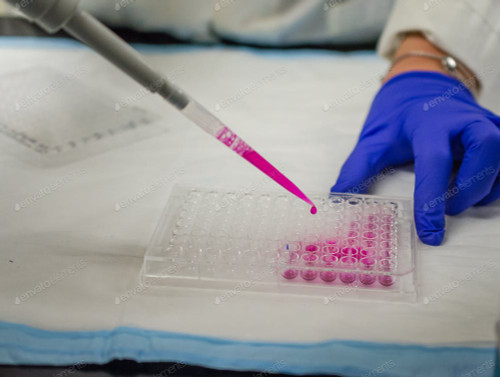Product Description
Recombinant Mouse Tumor necrosis factor ligand superfamily member 11 (Tnfsf11), partial is available at Gentaur for Next week Delivery.
Gene Name: Tnfsf11
Alternative Names : Osteoclast differentiation factor Short name:ODF Osteoprotegerin ligand Short name:OPGL Receptor activator of nuclear factor kappa-B ligand Short name:RANKL TNF-related activation-induced cytokine Short name:TRANCE CD_antigen: CD254
Expression Region : 70-316aa
AA Sequence : YFRAQMDPNRISEDSTHCFYRILRLHENADLQDSTLESEDTLPDSCRRMKQAFQGAVQKELQHIVGPQRFSGAPAMMEGSWLDVAQRGKPEAQPFAHLTINAASIPSGSHKVTLSSWYHDRGWAKISNMTLSNGKLRVNQDGFYYLYANICFRHHETSGSVPTDYLQLMVYVVKTSIKIPSSHNLMKGGSTKNWSGNSEFHFYSINVGGFFKLRAGEEISIQVSNPSLLDPDQDATYFGAFKVQDID
Sequence Info : Extracellular Domain
Tag Info : N-terminal 6xHis-SUMO-tagged
Theoretical MW : 43.9 kDa
Storage Buffer : Tris/PBS-based buffer, 5%-50% glycerol. If the delivery form is lyophilized powder, the buffer before lyophilization is Tris/PBS-based buffer, 6% Trehalose, pH 8.0.
Endotoxin Level : Not tested-
Biological Activity : Not tested
Storage : Short term: -20°C; Long term: -80°C. Minimize freeze and thaw cycles.
Research Area : Others
Restriction : For Research Use Only. Not for use in diagnostic procedures, drug use, or for administration to humans or animals.
Relevance : Cytokine that binds to TNFRSF11B/OPG and to TNFRSF11A/RANK. Osteoclast differentiation and activation factor. Augments the ability of dendritic cells to stimulate naive T-cell proliferation. May be an important regulator of interactions between T-cells and dendritic cells and may play a role in the regulation of the T-cell-dependent immune response. May also play an important role in enhanced bone-resorption in humoral hypercalcemia of malignancy.
Function : Cytokine that binds to TNFRSF11B/OPG and to TNFRSF11A/RANK. Osteoclast differentiation and activation factor. Augments the ability of dendritic cells to stimulate naive T-cell proliferation. May be an important regulator of interactions between T-cells and dendritic cells and may play a role in the regulation of the T-cell-dependent immune response. May also play an important role in enhanced bone-resorption in humoral hypercalcemia of malignancy (By similarity). Induces osteoclastogenesis by activating multiple signaling pathways in osteoclast precursor cells, chief among which is induction of long lasting oscillations in the intracellular concentration of Ca (2+) resulting in the activation of NFATC1, which translocates to the nucleus and induces osteoclast-specific gene transcription to allow differentiation of osteoclasts
Involvement in disease : Deficiency in Tnfsf11 results in failure to form lobulo-alveolar mammary structures during pregnancy, resulting in death of newborns. Trance-deficient mice show severe osteopetrosis, with no osteoclasts, marrow spaces, or tooth eruption, and exhibit profound growth retardation at several skeletal sites, including the limbs, skull, and vertebrae and have marked chondrodysplasia, with thick, irregular growth plates and a relative increase in hypertrophic chondrocytes.
Subcellular location : Isoform 1: Cell membrane, Single-pass type II membrane protein, SUBCELLULAR LOCATION: Isoform 2: Cell membrane, Single-pass type II membrane protein, SUBCELLULAR LOCATION: Isoform 3: Cytoplasm, SUBCELLULAR LOCATION: Tumor necrosis factor ligand superfamily member 11, soluble form: Secreted
Protein Families : Tumor necrosis factor family
Tissue Specificity : Highly expressed in thymus and lymph nodes, but not in non-lymphoid tissues and is abundantly expressed in T-cells but not in B-cells. A high level expression is also seen in the trabecular bone and lung.
Paythway :
Uniprot ID : O35235
 Euro
Euro
 British Pound
British Pound
 US Dollar
US Dollar








